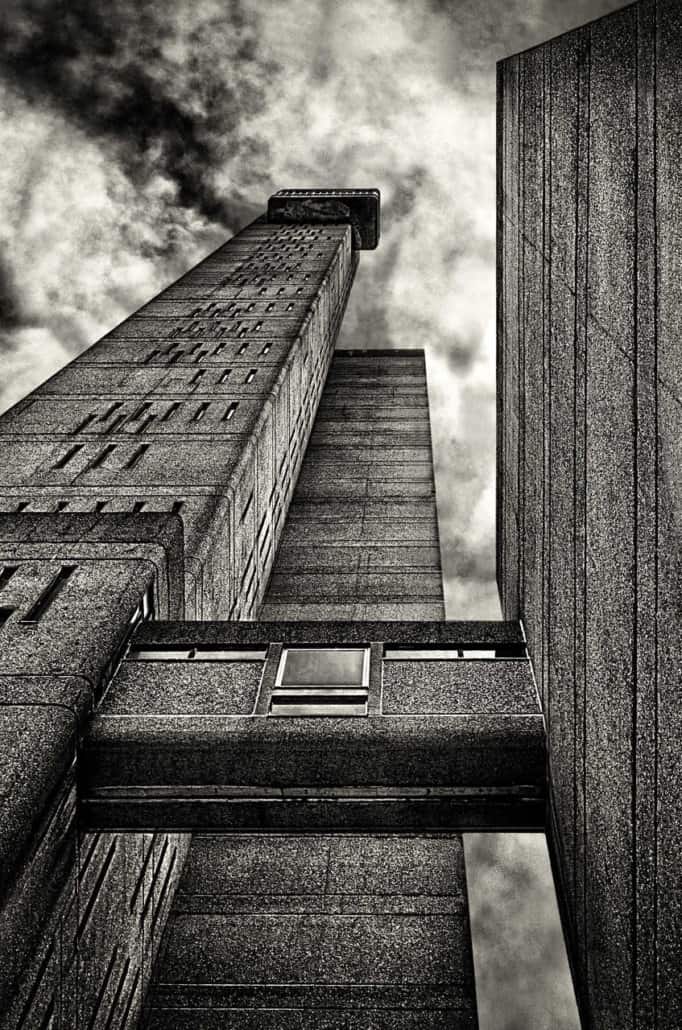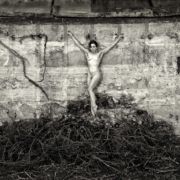Trellic Tower

Trellick Tower is located on the Cheltenham Estate in Kensal Town, London. Opened in 1972, it had been commissioned by the Greater London Council and designed in the Brutalist style by architect Ernő Goldfinger. The tower was planned to replace outdated social accommodation, and designed as a follow up to Goldfinger’s earlier Balfron Tower in East London. It was the last major project he worked on, and featured various space-saving designs, along with a separate access tower containing a plant room.
High-rise apartments and Brutalist architecture were falling out of favour by the time the tower was completed, and it became a magnet for crime, vandalism, drug abuse and prostitution. Its fortunes gradually improved in the 1980s after the establishment of a residents’ association. Security measures were put in place and a concierge was employed, which led to lower crime levels. By the 1990s the tower had become a desirable place to live, and although it still contains predominantly social housing, demand for private flats has remained high. A local landmark, it has retained its distinctive concrete facade as a result. A fire broke out in 2017, but the concrete structure meant damage was limited, unlike the nearby Grenfell Tower. Trellick Tower has featured on film and television several times. The tower is 98 metres tall. It has a long, thin profile, with a separate lift and service tower linked at every third storey to the access corridors in the main building, which overall has 31 floors. Flats above and below the corridor levels have internal stairs, while the 23rd and 24th floors are taken up by maisonettes split over the two floors.
The service tower has two additional floors higher than the main building, which includes a projecting plant room that holds the main heating system. It is fully linked by stairs in addition to the lifts, and also has a refuse chute mechanism. The majority of the plant and the hot water storage tank is located in the plant room, which reduces the need for pumps and reduces the amount of pipework needed. Shorter pipe runs also reduce heat loss. The oil-fired boilers originally used became obsolete due to the 1973 oil crisis, the year after the tower opened. The flats now have electric heaters and the plant room, although disused, still houses most of the now defunct mechanism.
Goldfinger designed the entire tower block freehand on butcher’s paper. He planned various communal areas, and purposefully put slight variations in the structure so that each apartment would look different. Throughout, quality materials were used in construction, including better fixtures and finishing the balconies with cedarwood. It it was intended to be a good example of social accommodation alongside modern design.
Goldfinger had been encouraged to construct Trellick Tower by the London County Council. He took his inspiration from Balfron, where he had moved into one of the apartments in order to experience what life would be like for the tenants, and invited residents round for regular cocktail parties to tell him their likes and dislikes. This feedback was incorporated into the design of Trellick Tower. Many immigrants from the West Indies and the Caribbean settled in Trellick Tower, as for them it was one of the few affordable places to live in London. Construction costs ran to £2.4 million.
By the time Trellick Tower opened, high-rise tower blocks were becoming unfashionable. Goldfinger had intended that tenants should to be vetted for suitability, and petitioned the Council for the building to have proper security and a concierge but to no avail. This meant that the building was open access, and rough sleepers and drug criminals took up residence in its corridors. Drying rooms on the ground floor, designed by Goldfinger to stop tenants hanging laundry on the balconies, were vandalised before the tower block opened.
By the late 1970s Trellick Tower was a scene of crime and anti-social behaviour, and many tenants were very reluctant to move in. On one occasion vandals set off a fire extinguisher on the 12th floor, with water from the sprinkler system flooding the lifts and leaving the tower without electricity, heat or running water over the Christmas period. A pensioner was forced to use the stairs after all the lifts were out of order, and subsequently collapsed and died. On the 15th floor, a 27-year-old woman was dragged from one of the lifts and raped. The tower became nicknamed “The Tower of Terror” and residents attempted to be re-housed. In 1982 a man was killed after jumping off the top of Trellick Tower when his parachute failed to open. He was a member of a group of dangerous sports enthusiasts who were interested in jumping off fixed objects.
With the introduction of the “right to buy” council homes, several of the flats were bought by their tenants. On 8 October 1984 a new residents’ association was formed. As a result of pressure from the occupants, several security improvements including a door entry intercom system were installed and a concierge was hired in 1987. In 1994 residents in the tower, along with other residents in Kensington & Chelsea council properties, elected to self-manage the properties, in order to avoid increased rents and the threat of eviction.
In 1991 Sand Helsel, Professor of Architecture at RMIT, made a BBC documentary praising Trellick Tower, which helped to change public opinion in its favour. The tower subsequently became more respectable owing to its location in Notting Hill and the gentrification of Golborne Road. Property prices rose and flats in the tower came to be regarded as highly desirable residences; requests to sell flats began to be posted on the tower’s communal noticeboard. By 1999 a flat in the tower could sell for £150,000 (£239,000 as of 2016). The tower itself has become something of a local cult landmark and was awarded a Grade II listing in 1998, which included the main building and the adjacent row of shops and amenities.
On 19 April 2017 the top floors of the tower caught fire, believed to have been started by a discarded cigarette. There were no injuries. The building’s listed status meant that the concrete facade could not be covered over, which is thought to have prevented a far worse fire similar to Grenfell Tower which happened a few months later.









Leave a Reply
Want to join the discussion?Feel free to contribute!